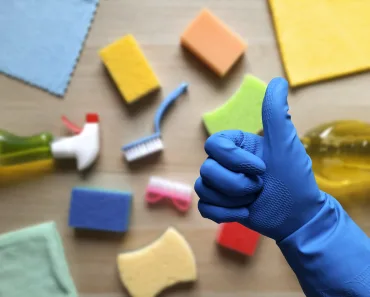What’s worse than that musty, damp smell in your house that you can’t get rid of? Not knowing where it’s coming from! In this guide, you’ll learn everything you need to know about excess moisture in your home – signs you have too much damp, what causes it, and how to prevent it.

Where Does Excess Moisture Come From?
Moisture can come from several places in your home, and some moisture problems are easier to tackle than others. Leaving your wet laundry out to dry and causing condensation on the windows is an easy fix – find another location to hang up your wet laundry. If your moisture is coming from excess water in the ground soil around your home and seeping up into the walls, then you have a bigger problem.
Moisture can come from a plumbing leak, damaged roof, or saturated walls. If you detect a damp smell but aren’t sure what’s causing it, check your pipes (which could be leaking), your rain gutters (which might not be draining water correctly), or your walls (which could be clogged with moisture). This guide gives you tips for reducing excess moisture, however, if your damp problem is structural, you might have to call a professional.
Most homes will experience one of the following three types of excess moisture:
• Condensation: Condensation is the least serious of the three. When moisture comes into contact with a cold surface, little droplets of water will appear. Walls, windows, and mirrors are particularly prone to condensation. Some condensation on the bathroom mirror after a shower is normal, but mold around the window sills is not.
• Penetrating Damp: Penetrating damp happens when water moves through an entire building. Water can get in through damaged gutters, porous masonry, and faulty roof fabric. Once the water gets in, it will seep through cracks and joints in the walls, resulting in moisture inside your home.
• Rising Damp: Rising damp comes from the water in the ground soil around your house. It moves up through the structure of your home. Rising damp only affects the ground floor, so if you have moisture on upper levels, it’s likely either condensation or penetrating damp.
What Are the Signs of Moisture and Damp?
A damp smell is a giveaway that you have too much moisture. But that musty odor doesn’t always accompany damp in your home. How can you tell if you have a moisture problem? Look for these signs.
• Stains and tide marks – You might notice stains on your walls if you have too much damp. Some of these stains, called tide marks, are the salt that’s leftover after the groundwater evaporates. Stains could be yellowish or brown, about six feet above the baseboards.
• Decaying baseboards – Rotting timber is a telltale sign of excess moisture. Your baseboards might have cracks, fungus, or decaying paint as a result of damp.
• Peeling wallpaper – Wallpaper that curls upward from the baseboard is a good indication you have excess moisture.
You should also look for damaged timber (not just baseboards, but anywhere there’s exposed wood in your home), watermarks on the masonry, and black mold on interior walls.
Addressing Moisture in the Bathroom
Bathrooms are one of the biggest culprits for excess moisture. If you want to prevent damp in this room of the house, you need to check on your ventilation and heating. If you have a window in your bathroom, open it when you take a shower to help air flow outside, or turn on your extractor fan. If your bathroom doesn’t have heating, like a radiator or underfloor heating, then the room could be more prone to condensation as well.
If you have regular problems with damp in your bathroom, it might be your plumbing. Look for leaks in your pipes and taps. Another habit to get into is wiping down surfaces in the bathroom. Quickly going over the mirror, countertops, and even inside the shower can mitigate moisture in the bathroom.
You can also make a few adjustments to your bathroom to prevent damp from setting in. A dehumidifier filters through the tiny amounts of moisture in the air, and moisture-resistant paint provides an extra layer of defense.
Tackling Basement Moisture
You might have too much moisture in your basement as a result of internal sources. If you have a humidifier or a kitchen unit in your basement, the room could be prone to damp. Removing items or stopping activities that cause damp is a good first step. If you have too much condensation in your basement, installing air conditioning with a dessicant-type heat exchanger could address it as well.
If your basement has too much damp, you may have to contact professionals about basement tanking. Tanking involves adding a waterproof cement to your basement walls, prevent them from cracking or breaking from hydrostatic pressure. Adding a membrane, such as a damp-proof course, to the structure of your home might also help prevent rising damp.
Sometimes, adding a membrane or coating is only a temporary fix for damp basements. Modifying your drainage system might be the best approach, depending on your situation. Checking gutters, downspouts, surface grading, or adding a sub-slab depressurization system might be your best course of action.
Getting Rid of that Musty Smell
Although you’d like to prevent excess moisture from setting in before it creates a bad odor, sometimes you have to deal with the smell after the fact. Here are the best ways to eliminate a damp odor your home.
• Wash fabrics – The cause of the musty smell might be damp fabrics like blankets, clothing, rugs, or towels. Letting these items dry won’t get rid of the smell, so you’ll have to wash them. After they’re done in the washing machine, wash each piece again by hand with soapy water and vinegar. Instead of throwing them in the dryer, hang your fabrics to dry out in the sun.
• Lemon – The smell of lemon can help overpower even the mustiest of odors. To make your home smell more lemony, boil the peels of one lemon for two minutes. Let the water and peels cool, then set it around your house or put it into a spray bottle.
• Baking soda – Baking soda helps absorb moldy smells. Put some baking soda in a small box or on a small plate in the smelly room and leave it for 24 hours. Repeat this process every few months or however often is needed to keep the odor at bay.
• Vinegar and water – Fill a spray bottle with white vinegar and water. Spray surfaces like countertops, windows, and cabinets.
• Repainting – If you’ve tried several deodorizing techniques and nothing seems to work, you could repaint your walls. A fresh coat of paint will help cover up that moldy smell.
Final Thoughts on Minimizing Moisture and Musty Smells
When your home smells musty, you don’t feel comfortable, and big problems can arise from too much damp – structural home issues and personal health complications. When you know the causes of excess moisture, you can actively prevent it.



